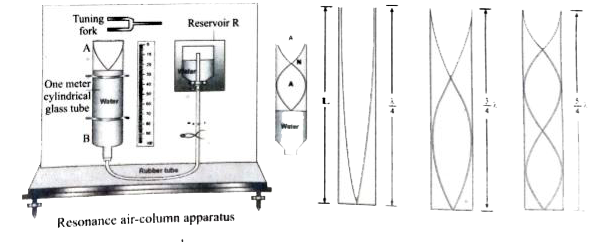How will you determine the velocity of sound using resonance air column apparatus ? Solution in Tamil
The resonance air column apparatus is one of the simplest techniques to measure the speed of sound in air at room temperature. It consists of a cylindrical glass tube of one meter length whose one end A is open and another end B is connected to the water reservoir R through a rubber tube as shown in figure. This cylindrical glass tube is mounted on a vertical stand with a scale attached to it. The tube is partially filled with water and the water level can be adjusted by raising or lowering the water in the reservoir R. The surface of the water will act as a closed end and other as the open end. Therefore, it behaves like ·a closed organ pip·c, forming nodes at the surface of water and antinodes at the closed end. When a vibrating tuning fork is brought near the open end of the rube longitudinal waves are formed inside the air column. These waves move downward as shown in Figure, and reach the surfaces of water and get reflected and produce standing waves. The length of the· air column is varied by changing the water level until a loud sound is produced in the air column. At this particular length the frequency of waves in the air column resonates with the frequency of the tuning fork (natural frequency of the tuning fork). At resonance, the frequency of sound waves produced is. equal to the frequency of the tuning fork. This will occur only when the length of air column is proportional to (14)th of the wavelength of the sound waves produced . Let the first resonance occur at length L1 , then

14λ=L1
But since the antinodes are not exactly formed at the open end, we have to include a correction, called end correction e·, by assuming that the antinode is formed at some small distance above the open end. Including this end correction, the first resonance is
14λ=L1+e
Now the length of the air column is increased to get the second resonance. Let L2 be the length at which the second resonance occurs. Again taking end correction into account, we have
34λ=L2+e
In order to avoid end correction, let us take the difference of equation (2) and equation (1) , we get 34λ−14λ=(L2+e)−(L1+e)⇒12λ=L2−L1=ΔL⇒λ=2ΔL
The speed of the sound in air at room temperature can be computed by using the formula
v=fλ=2ΔL
Further, to compute the end connection, we use equation (2) and equation (3 ), we get
e=L2−3l12
Topper's Solved these Questions
- BOOK - FULL MARKSCHAPTER - EXAMINATION QUESTION PAPER MARCH 2019EXERCISE - PART-III9videos
EXAMINATION QUESTION PAPER MARCH 2019
- BOOK - FULL MARKSCHAPTER - EXAMINATION QUESTION PAPER - JUNE 2019EXERCISE - PART IV10videos
EXAMINATION QUESTION PAPER - JUNE 2019
- BOOK - FULL MARKSCHAPTER - GRAVITATIONEXERCISE - ADDITIONAL QUESTIONS SOLVED (Numerical Problems)18videos
GRAVITATION
Similar Questions
What is the torque of the force →F=3ˆi−2ˆj+4ˆk acting at a point →r=2ˆi+3ˆj+5ˆk about the origin?
02:05View SolutionExplain in detail the triangle law of addition.
02:09View SolutionA geo-stationary satellite is orbiting the Earth of a height of 6R above the surface of Earth R being the radius of the Earth calculate the time period of another satellite at a height of 2.5R from the surface of Earth.
01:44View SolutionIn the experiment to determine the speed of sound using a resonance column,
02:47View SolutionIn a resonance tube experiment , the first resonance is obtained for 10 cm of air column and the sound for 32 cm . The end correction for this apparatus is
06:13View SolutionA tuning fork of frequency 500Hz is sounded and resonanace is obtained at 17cm and 52cm of air column respectively in a resonating air column apparatus. The velocity of sound in air is
05:18View SolutionIn the experiment to determine the speed of sound using a resonance column -
04:27View SolutionIn resonance apparatus for determining the velocity of sound in air, a turnning fork of frequency 320 Hz is used. A loud sound is heard when water level is at 24.8 cm and then at 78.5 cm. These lengths are called the first and second resonance lengths of air column in the resonance apparatus. Calculate the velocity of sound in air within the limits of permissiblr error.
04:23View Solutionअनुनाद नली क्या है ? इसके द्वारा वायु में ध्वनि की चाल कैसे ज्ञात करते है ?
04:23View SolutionWhat do you understand by 'resonance '? How would you use resonanceto determine the velocity of sound in air ?
10:23View SolutionHow will you determine the velocity of sound using resonance air column apparatus ?
04:23View SolutionHow will you determine the velocity of sound using resonance air column apparatus ?
04:23View SolutionHow will you determine the velocity of sound using resonance air column apparatus ?
View SolutionHow will you determine the velocity of sound using resonance air column apparatus ?
05:41View SolutionHow will you determine the velocity of sound using resonance air column apparatus ?
02:34View Solution

